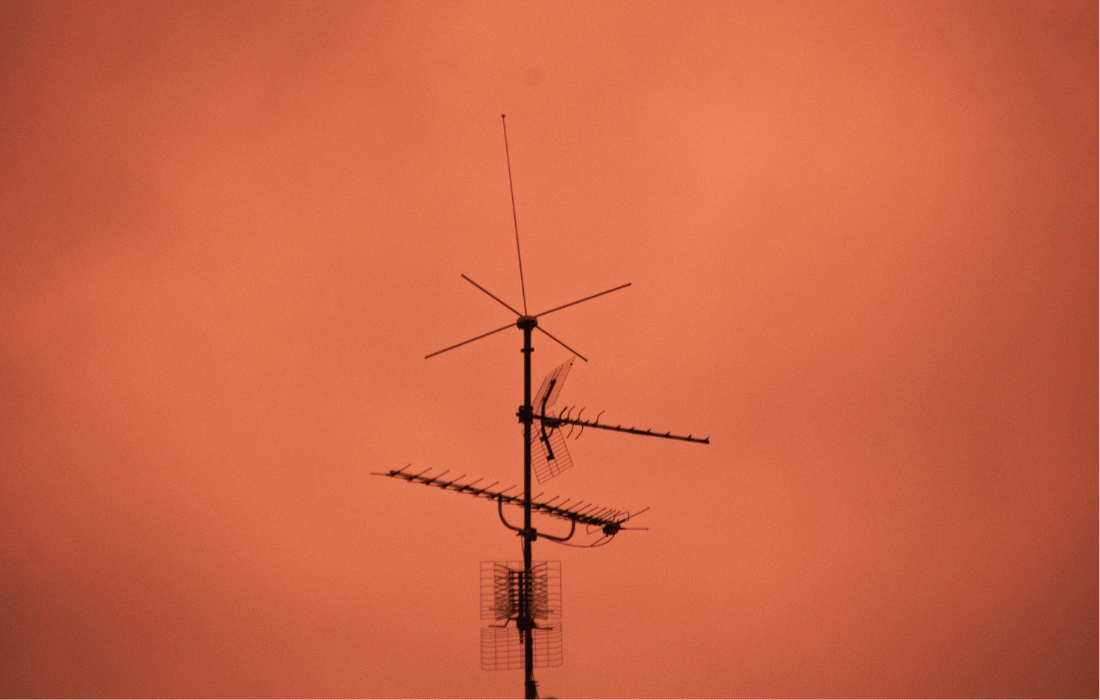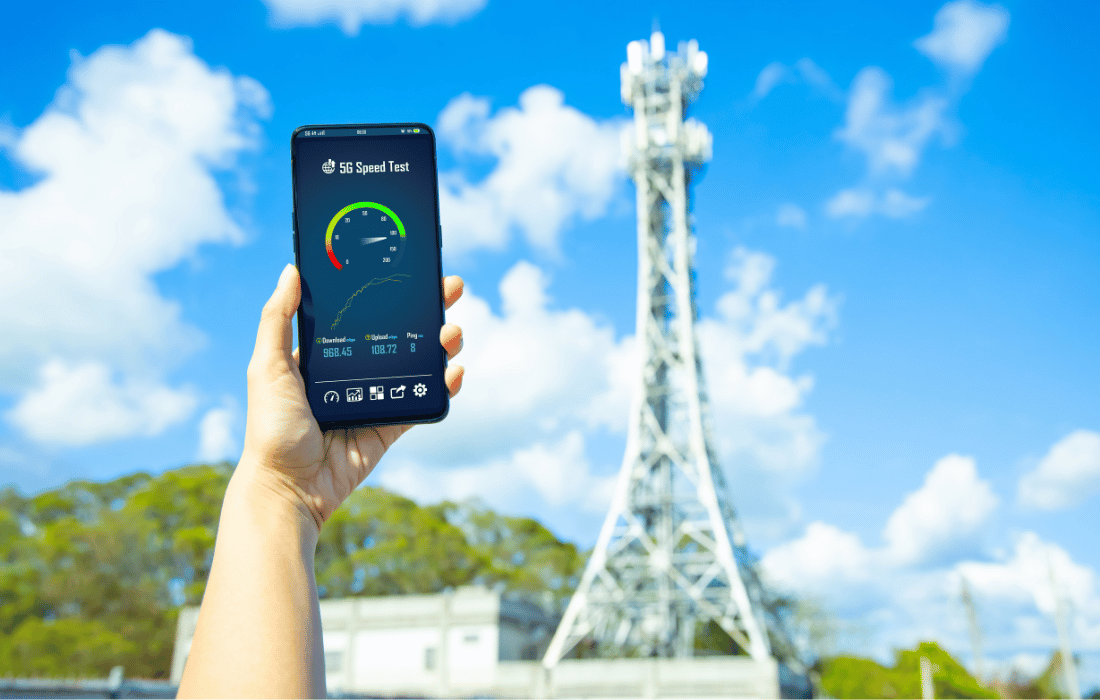We were promised a futuristic leap: lightning-fast connections, smarter cities, self-driving cars that actually work. And yeah, 5G is impressive on paper. But buried under the tech buzz is a rising wave of concern, not just from the usual fringe voices, but from everyday folks asking real questions:
What does 5G actually do to our bodies?
Why does it feel like we’re swimming in invisible signals all day?
And what in the world is “electrosmog”?
For all the talk about innovation, there’s been surprisingly little mainstream discussion about 5G’s impact on human health, especially when it comes to the largest organ we have: our skin. Let’s unpack what’s true, what’s overblown, and what still requires serious investigation.
What Exactly Is 5G?
Let’s start with the basics.
5G stands for “fifth-generation” mobile network — it’s the successor to 4G LTE. But the real change isn’t just faster speeds. 5G brings:
New frequencies (some in the millimeter-wave range — think 24–100 GHz)
More antennas (because higher-frequency waves don’t travel far)
“Beamforming” technology that targets devices more precisely
Massive device density — millions more connections per square mile
Now, technically, we’ve been bathing in non-ionizing radiation (that’s what radiofrequency or RF is) for decades. WiFi, Bluetooth, cell towers, baby monitors, smart meters, it’s nothing new. But 5G dials it up.
Higher frequencies. More devices. Denser infrastructure.
The question isn’t just “is it new?”, the question is: is it biologically relevant?
Skin: The Unsung Frontline
While millimeter wave frequencies used in upper-band 5G are largely absorbed at the skin’s surface, the skin is not a passive barrier. It’s an electrically active, immunologically sensitive, and neurologically rich organ, capable of initiating systemic biological responses. And when you factor in the overlap of mid-band 5G with older frequencies that penetrate more deeply, plus cumulative exposure from multiple EMF sources (a.k.a. electrosmog), the effects likely go beyond skin-deep.
So if there’s going to be an impact, our skin is the first battleground.
What’s more, our skin is loaded with nerve endings, immune cells, blood vessels… It’s not just a passive barrier. It’s a biologically active, signaling organ. It reacts, adapts, and yes, it could get stressed by chronic exposure to electromagnetic fields, if that stress is real.
But is it?
So, Does 5G Affect Skin Cells?
Short answer: signs point to yes, and not only skin cells. While industry talking points emphasize that higher-band 5G (especially mmWave) “only” reaches the skin, the skin isn’t a parking lot; it’s a biologically active interface loaded with immune cells, mast cells, microvasculature, and dense neural endings. Stimulate this layer chronically, and you can broadcast signals to the rest of the body, oxidative stress mediators, inflammatory cytokines, and neurosensory inputs, that don’t stay local. And we already have lab and animal data showing downstream damage from RF exposures in the 2G–5G range.
What the Lab and Animal Data Actually Show:
If you dig into the actual research, not the PR blurbs or industry white papers, a pretty clear pattern starts to appear. Across cell cultures, animals, and even human studies, we see the same thing showing up again and again: oxidative stress, DNA damage, and cellular disruption at exposure levels that are supposedly “safe.”
It’s not all one smoking-gun study; it’s the consistency of the biological response that’s hard to ignore. Here’s what the data really says.
1. DNA Damage and Cellular Stress
One of the most respected pieces of early research came from a 1995 study by Bioelectromagnetic. They exposed rat brain cells to microwave radiation, similar to what’s used in today’s wireless bands, and found significant single- and double-strand DNA breaks. No heating, no burns, just broken genetic material.
That finding has since been echoed in dozens of experiments showing elevated reactive oxygen species (ROS), mitochondrial dysfunction, and impaired DNA repair after chronic RF exposure. These are the same biological fingerprints you see in early-stage aging and disease processes.
2. Neurological and Blood-Brain Barrier Effects
In 2003, Leif Salford’s group at Lund University discovered something shocking: rats exposed to GSM-type mobile signals had leaky blood-brain barriers, meaning the normally tight seal protecting the brain from toxins was literally opening up. They also found neuronal damage in the cortex and hippocampus, areas responsible for memory and learning.
Other labs have replicated aspects of this, showing changes in brain chemistry, reduced melatonin levels, and behavioral alterations in animals chronically exposed to RF fields. Even if higher-band 5G waves don’t reach the brain directly, the cascade of inflammation and oxidative stress initiated in the skin and peripheral tissues can still affect the nervous system indirectly.
3. Cancer and Long-Term Disease
When it comes to long-term outcomes, two large government-funded projects stand out:
The U.S. National Toxicology Program (2018) exposed rats and mice to 900 MHz GSM and CDMA signals for two years. The result? “Clear evidence” of malignant schwannomas of the heart and “some evidence” of brain gliomas in male rats.
Around the same time, the Ramazzini Institute in Italy found a statistically significant rise in the same heart tumors in rats exposed to far-field base-station-like RF.
Different labs, different exposure types, same tumor pattern. That’s not a coincidence, that’s a signal.
4. Reproductive and Developmental Harm
Male fertility has become another canary in the coal mine. A 2021 systematic review and meta-analysis in Environmental Research found that men with higher mobile-phone use had significantly lower sperm motility, viability, and concentration than those with minimal use. The mechanism again traced back to oxidative stress, damage to membranes, mitochondria, and DNA.
Animal studies mirror this, showing testicular degeneration, reduced testosterone, and embryonic developmental issues under chronic RF exposure. It doesn’t take a massive leap to see how the same stressors could scale up across generations.
5. Millimeter-Wave Skin and Immune Reactions
mmWave power is mostly absorbed in the outer ~0.5–1 mm of skin, which means effects are largely superficial and thermal at typical public exposures. Dosimetry work shows that penetration is deep enough to reach nerve endings, capillaries, and immune cells in the epidermis/upper dermis, but not in deeper organs.
Thermal-threshold findings (supportive of current limits). Under controlled local exposures, rat-skin experiments at ~26.5 GHz found temperature rises that scale with intensity and, within those conditions, concluded the operational threshold underlying mmWave guidelines was valid. In short: with those powers/durations, no injury beyond expected heating.
Evidence of injury/inflammation at higher local loads. A newer follow-up in rats reported that sufficiently intense localized 26.5 GHz “quasi-mmWave” exposure produced burn-like degeneration and a robust inflammatory response in skin — i.e., biologic injury when thermal loading is high enough. This underscores the point that mmWave effects are mainly thermal, but not trivial if local power density is high.
Gene-expression changes in skin cells (mixed results). Human keratinocyte studies have reported mmWave-linked gene-expression modulation under certain intensities/exposure patterns, while others found minimal or heat-driven changes unless cells were metabolically stressed. Net takeaway: possible transcriptomic nudges, but small and not consistently non-thermal.
Why “Skin-Only” Is Biologically Naive
Even if a given 5G band deposits most energy in the epidermis/dermis, the skin talks. Mast-cell degranulation, ROS bursts, neurogenic inflammation, and microvascular signaling can propagate beyond the exposure site. Add mid-band 5G (e.g., 3.3–3.8 GHz), which penetrates deeper than mmWave, and the cumulative exposure picture looks a lot less comforting. Regulators themselves acknowledge that long-term data at higher bands is thin, not definitive. “Absorbed mostly by skin” ≠ “biologically irrelevant.”
Electrosmog is just the sum of all wireless fields around you, phones, Wi-Fi, wearables, smart meters, small cells, cars, and even your neighbor’s router bleeding through the wall. It’s not one tower; it’s everything, stacked and constant. Even the World Health Organization notes that EMFs are now one of the most common environmental influences, and overall population exposure keeps rising as tech spreads.
Why Cumulative Exposure is the Point (Not a Single Tower)
Guidelines (ICNIRP/2020) are built to prevent heating. If you stay under those thermal thresholds, regulators say you’re fine. That’s their frame.
However, non-thermal biology, particularly oxidative stress, continues to emerge across in-vitro and in-vivo studies, and it doesn’t require a temperature rise. The Swiss BERENIS expert group’s 2021 review of ~150 animal/cell studies concluded that the majority of animal studies and over half of cell studies showed increased oxidative stress from EMF exposure, while noting methodological gaps that need tightening.
Add the bigger health context: chronic multi-stressor life (sleep debt, chemicals, noise, light-at-night) builds allostatic load, the wear-and-tear of constant stress. Electrosmog slots into that same bucket; it’s part of the total load, even if each single source looks small.
Where Consensus and Caution Collide
WHO: no causal link confirmed to date (and they also admit few studies have looked at true 5G frequencies so far).
IARC: RF-EMF is Group 2B “possibly carcinogenic”=—and a re-evaluation is underway.
European Parliament STOA: 5G changes exposure patterns; evidence for carcinogenic and reproductive risks exists from prior bands; data gaps remain (especially long-term, higher bands).
Independent researchers argue current limits don’t account for non-thermal biology, listing cancer, oxidative stress, reproductive, and neuro effects reported below guideline levels.
Practical Ways To Cut Exposure (Without Killing Performance)
Use these quick, no-drama tweaks (distance, time, and smarter device settings) to cut your personal RF load fast without sacrificing performance or your training tech.
1. Phone Setup For Athletes
Use Airplane Mode during sleep, film review, or recovery blocks when you don’t need cellular.
Prefer Wi-Fi Calling in strong Wi-Fi; phones transmit less vs. weak cellular.
Keep phones off-body as much as possible; avoid front-pocket carry (hips/groin).
Download playlists/maps offline for travel; stream less in metal buses.
2. Wearables, Headsets, And Sensors
Disable cellular on watches unless needed; sync in batches.
Use wired or low-power Bluetooth earbuds for long calls.
Mount bike computers/sensors away from the pelvis when possible.
3. Facilities And Travel
Place team routers away from treatment tables and sleep spaces in facilities or hotels; don’t mount access points directly above recovery areas.
On flights/buses, keep devices on Airplane Mode when signal is poor to prevent power ramping.
4. Recovery And Sleep
Make the bedroom a low-RF zone: airplane mode, no bedside charging, distance from routers.
Aires 5G EMF Modulation: Performance Protection Without Sacrifice
You’ll see products claiming to “harmonize” or “modulate” EMF. Aires (American Aires) markets silicon-based resonators designed to alter incident fields.
Aires Tech devices don’t block EMFs. That’s not their job.
Instead, they work by modulating the chaotic, man-made waveforms, like those from 5G, Wi-Fi, or Bluetooth, into more biologically harmonious sinusoidal patterns. This helps the body stay in homeostasis and reduces the cellular chaos that normally occurs when we’re hit with pulsed, erratic signals all day long.
Think of it as smoothing out the static in your environment, so your body isn’t constantly trying to defend itself behind the scenes. And for athletes, that’s huge. The more regulated your nervous system is, the faster you recover, the sharper your reflexes, and the deeper your sleep.
The Aires Lineup: Choose What Fits Your Lifestyle

Save 25% on Aires EMF protection devices with code “MOL” Aires One – Ideal for phones, laptops, tablets, or wireless headphones. Stick it directly on your device. This is your first line of defense, especially considering how often your phone is in your pocket or near your head.
Aires Go – A compact, portable option meant for on-the-go use. Clip it to your keychain, backpack, or your dog’s collar. It travels with you and creates a protective bubble around your body when you’re moving through high-EMF environments.
Aires Flex – Worn as a necklace or lanyard, this one offers slightly more range than the Go. Perfect for trainers, coaches, or athletes who are constantly on the move during games, practices, or travel.
Aires Zone – Designed for home, offices, or treatment rooms, this sits on a desk or shelf and modulates the EMF environment in larger indoor areas.
Aires Zone Max – For locker rooms, weight rooms, open training spaces, or even your entire home. This is the most powerful option, covering a broad area with stable, consistent EMF modulation.
The Takeaway: Your Environment Is Training You, Too
You don’t have to see radiation for it to affect your performance. And with 5G, Wi-Fi 6, Bluetooth, smart everything, it’s no longer about a single source. It’s about the cumulative load your body is silently trying to manage while you’re trying to win, recover, or just show up at your best.
The truth is: 5G does penetrate deeper than “just the skin” when you look at the totality of effects: oxidative stress, mitochondrial disruption, blood-brain barrier changes, and nervous system interference. And if you’re training hard, cutting weight, or trying to optimize recovery, that invisible stress can stack up fast.
But this isn’t about fear. It’s about awareness and performance advantage.
So if you’re already dialed into nutrition, recovery, and training… don’t ignore the electromagnetic piece of the puzzle. You don’t need to live in a cabin in the woods or ditch all your devices. Just start with a few smart changes:
Modulate your environment with tools like Aires (save 25% on all Aires EMF protection products with code “MOL”)
Reduce exposure when and where you can (especially during sleep)
Support your biology with grounding, red light, antioxidants, and deep sleep
At the end of the day, your body is the arena. You can’t perform at your best if the system is under constant noise. Clean up your environment, and your cells will respond in kind, with more energy, faster recovery, and sharper focus.
Because it’s not just about what you put into your training.
It’s about what you take out of your environment.

















